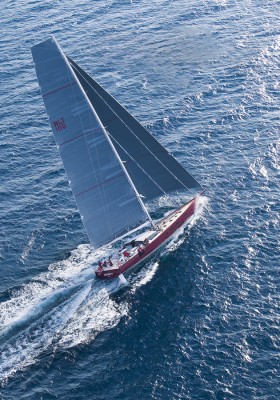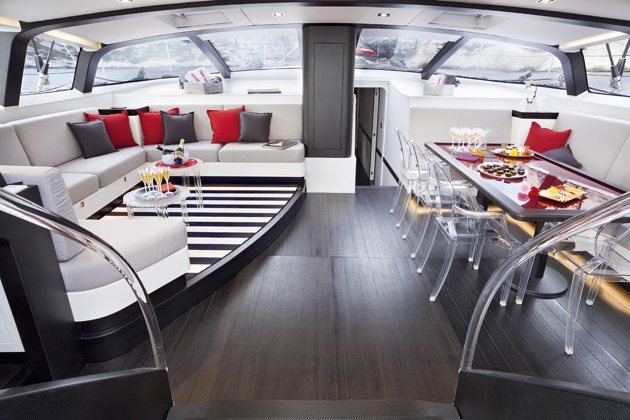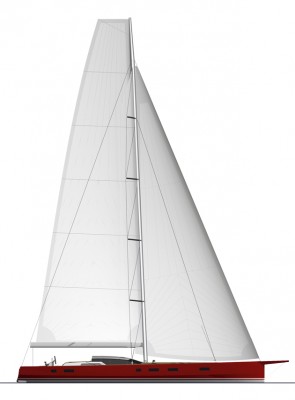Elaine Bunting is blown away by the superfast 100 footer Nomad IV from Finot-Conq, the design team's first foray into large cruisers
A Mistral is blowing 30 knots out of an empty sky. Once the mainsail of Nomad IV is hoisted to the second reef point and the J2 jib snaps out, we are off. Hitting 20 knots as we are fired out of Marseille, our wake streams astern like a river in spate. The 100 foooter is going so fast that by the time the spray from the bow atomises in the wind it is already at our lee quarter, refracted into a rainbow.
The raw sensation of power is what you might expect on muscle boats such as a Volvo Ocean 65 or a Vendée Globe racer. But this is the carbon super-cruiser Nomad IV, according to designers Finot-Conq ‘the world’s fastest 100ft cruising yacht’, and as Ile de Porquerolles rolls by, the bear away is no more than a helmsman’s finger jab at one of the control panels.
The aroma of dinner being prepared by the chef wafts up through the companionway. On a yacht that could easily gobble up 400 miles a day, it is reassuring to know that, come what may, there will be canapés at eight.
With her bowsprit, plumb bow, chines and huge beam carried right aft, Nomad IV is a dead ringer for those ocean racers, and with good reason. For a cruising boat with a comfortable proportion of that power and performance, the owner turned to the French design group renowned for their mastery of short-handed offshore racers, from Mini Transat pocket rockets to IMOCA 60s.
Lead designer Pascal Conq has been behind numerous groundbreaking innovations over the past 30 years, yet he and his team had never before been commissioned to design a yacht of this size.
A true sailor’s superyacht
The owner, a French IT and telecoms entrepreneur, wanted a 100 footer that he could race and charter, cruise round the world and take part in ocean racing classics such as the Middle Sea Race, the Fastnet and Sydney-Hobart. A lifelong sailor, he grew up with yachts and in his twenties sailed around Europe and to the Azores with his family in their 44ft steel Frans Maas design – “in the days of sextants,” he adds. After years of owning motor boats, he wanted a yacht on which he could entertain, so the brief was for a yacht with cabins for 12 guests, four permanent crew and a cockpit that could hold 50 people.
The yacht should be capable of entering shoal waters – the keel lifts from 5.4m to 3m – and not heel to more than 12°, so that his wife and any nervous guests would feel more at ease on board. Above all, she had to be a yacht for sailing – fast.
From all these ingredients, Finot-Conq have come up with a true sailor’s superyacht, one that that is scorchingly quick, looks gorgeous at anchor and has a dramatic interior that is simple and modern rather than one weighed down by opulence. By stripping back weight and complication, and using solo race boat technology, Nomad IV needs only a small crew.
Design work began in 2010 and she was three years in build at the Maxi Dolphin yard in Italy before her launch this year. The FC100 has been referred to as Finot-Conq’s take on the Wally Cento: an offshore racer, lightning fast high-tech cruiser and luxury charter boat. She carries up to 690m2 of sail upwind, but to give her stability has an enormous beam of 8.3m, probably the widest of any yacht of this length built to date, and can load in 9 tonnes of water ballast, the equivalent of 100 people on the rail.
Taking the helm
The benefit of ballast can be felt beneath the feet, and as we harden up towards Saint Tropez in a dying breeze, the main is raised to full hoist and the J1 is unfurled. The owner offers me the helm as we tack up into the bay. Thrillingly, the boat spins crisply through the wind and when I let her draw up on the new hand, and feather the boat into the gusts as they bullet off the shore, the helm remains light, with a neutral feel very similar to wheel-steered IMOCA 60s.
That she sails and feels similar to the powerful, but forgiving Open class raceboats is unsurprising, but it did challenge the designers. “There is a lot of volume and the boat is very beamy, very powerful and stable,” says Pascal Conq. “It was a big step-up in size, but we have been able to apply what we’ve learned from our racing boat experience. It [posed] some architecture problems; the power of the shape, the keel structure and load points, but that is what we really like to do.”
Building a full carbon cruiser with Nomex interior, despite the huge expense involved, has its pay-offs for a cruising yacht, insists Conq: “The advantage is that it is stronger and if you invest in a light design you can get more equipment for comfort for the same weight and divide the benefit.”
Every possible item was pared back. For example, there are only three winches at the mast so halyards are reeved through open blocks rather than fixed turning blocks. As is standard on grand-prix racers, halyard locks in the mast are used to reduce compression loads and allow for a lighter carbon mast.
Full of light
Nomad IV’s showpiece is her deck saloon, a few steps down from deck level. This big, bright area is full of space and light thanks to windows all the way round. The ingenious trick performed by Finot-Conq’s interior designer, Pierre Forgia, is that it is large enough to lend shelter to the seating area of the cockpit, but not so bulky as to detract from the boat’s sleek lines.
As we enter the harbour at Saint Tropez, the owner declines the help of his skipper to do a very neat piece of stern-to parking. The hostess emerges with champagne and canapés, along with plastic flute glasses and plates. The owner tells me he wanted plastic furniture, glasses and plates to save weight. He says this with a smile, but maybe it is true because this is a yacht with a firm sense of purpose.
This is an extract from a feature in Yachting World August 2014 issue













